“In the Master’s Footsteps” 24 Nov - 5 Dec 2014 (12D/11N)
Five holy places of Buddhist Pilgrimage:
(1) Lumbini in Nepal, the Buddha's birthplace
(2) Bodhgaya in India, the Buddha's enlightenment
(3) Sarnath in India, the Buddha's first sermon
(4) Vaishali Kothua in India, the Buddha's last sermon
(5) Kushinagar in India, the Buddha's passing away
We joined Buddhist monks and nuns from all over the world in paying homage to Lord Buddha at the Mahabodhi Main Temple and to perform Dana from as early as 5.00am.
Day 2 (25-11-2014) Dungeswari Cave and Sujata Stupa
The hotel morning call was at 4am and we had to be at the lobby by 4.45am. At 5am the bus took us to the Mahabodhi Temple for morning chanting and meditation beneath the Bodhi Tree and led by our group leader, Datuk Seri Dr. Victor Wee. We came back to the hotel at about 7am for breakfast. At 8am we left our hotel and walked to visit the following nearby temples:
(1) Daibutsu The Great Buddha Statue
(2) Karma Tharjay Chokhorling Kagyupa Vajrayana Buddhist Monastery
(3) The Royal Bhutanese Monastery
At 10am we went to the Himalaya shop as our members wanted to buy some of its herbal products. At 11am we offered Dana at Jaya Sri Mahabodhi Vihara Temple – Indian rupees 600 per pax. At 12.30pm we had lunch at the hotel. At 2.15pm we departed from the hotel by coach to visit the Dungeswari Cave. We arrived at the site at 3.15pm and climbed for about half an hour up the hill to the Cave. At 4.25pm we departed to visit the Sujata Stupa. It was rather dark by the time reached there.
At 6pm we had dinner at the hotel. At 7pm we paid a visit to the Bangladesh Buddhist Monastery. After holding prayers there, we were offered Masala tea by the monks. At 8pm we walked to the Mahabodhi Temple for meditation which lasted till 9pm. We took our coach back to our hotel for a good night's sleep.
Breakfast / Lunch / Dinner and overnight at Hotel Bodhgaya Regency.

Our Malaysian BGF members on entering the Mahabodhi Main Temple at 5.20am.

There was full of monks and devotees meditating at the Mahabodhi Temple compound.

The side wall of the Mahabodhi Temple. According to UNESCO, "the present Mahabodhi Temple is one of the earliest and most imposing structures built entirely in brick from the Gupta period".

Taiwanese Buddhist Monks chanting at the Mahabodhi Temple compound.
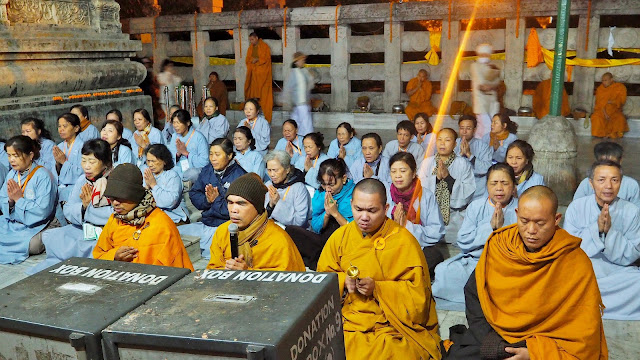
Vietnamese Buddhist Monks and devotees meditating and chanting at the Mahabodhi Temple compound.

Our Malaysian BGF members at the Mahabodhi Temple compound for early morning chanting and meditation beneath the Bodhi Tree led by our group leader Datuk Seri Dr. Victor Wee.

Monks and devotees meditating and chanting at the Mahabodhi Temple compound.
Monks and devotees meditating and chanting at the Mahabodhi Temple compound.
Our Malaysian BGF members at the Mahabodhi Temple compound for early morning chanting and meditation beneath the Bodhi Tree led by Datuk Seri Dr. Victor Wee.
Our Malaysian BGF members at the Mahabodhi Temple compound for early morning chanting and meditation beneath the Bodhi Tree led by Datuk Seri Dr. Victor Wee.
Y.S. Khong and Robert Chong performing sitting meditation at the Mahabodhi Temple compound.
Ching Bee Geok beside the Bodhi Tree at the Mahabodhi Temple compound.
Ching Bee Geok at the Mahabodhi Temple compound.
Ching Neng Bin at the Mahabodhi Temple compound.
Thai Buddhist Monks and devotees meditating and chanting at the Mahabodhi Temple compound.
Buddhist Monks from different countries meditating and chanting at the Mahabodhi Temple compound.
Mahabodhi Temple was constructed from bricks and is one of the oldest brick structures to have survived in eastern India. It is considered to be a fine example of Indian brickwork, and was highly influential in the development of later architectural traditions. 
Daibutsu The Great Buddha Statue in Bodhgaya.
Daibutsu The Great Buddha Statue in Bodhgaya. The statue about 25m (82 ft) high and in meditation pose or dhyana mudra was seated on a lotus in open air. It took about 7 years to complete with the help of 12,000 masons. It was built from a mixture of sandstone blocks and red granite. It is possibly the largest Buddha statue built in India. The foundation stone for the statue was placed in 1982 and the statue was later consecrated on 18th November 1989 by the 14th Dalai Lama.
Karma Tharjay Chokhorling Kagyupa Vajrayana Buddhist Monastery in Bodhgaya.
Karma Tharjay Chokhorling Kagyupa Vajrayana Buddhist Monastery in Bodhgaya.
Karma Tharjay Chokhorling Kagyupa Vajrayana Buddhist Monastery in Bodhgaya.
Royal Bhutanese Monastery in Bodhgaya, Bihar. The Monastery with its depictions of the life of Lord Buddha in artistic colourful clay carvings has attracted millions of Buddhist followers from all over the world. 
Ching Neng Bin, Y.S. Kong, Mike Khaw, Rober Chong, Tan Huat Chye and Wong Mun Heng at Royal Bhutanese Monastery in Bodhgaya, Bihar.
Royal Bhutanese Monastery in Bodhgaya, Bihar was constructed by King of Bhutan.
Royal Bhutanese Monastery in Bodhgaya, Bihar was constructed by King of Bhutan. The temple inside the Monastery has a 7-foot high image of Lord Buddh which was carved with additional Buddhist symbols and scriptures.
Royal Bhutanese Monastery in Bodhgaya, Bihar was constructed by King of Bhutan.
Royal Bhutanese Monastery in Bodhgaya, Bihar was constructed by King of Bhutan.
Royal Bhutanese Monastery in Bodhgaya, Bihar was constructed by King of Bhutan.
The 16th session of the Winter Debates began on 23-11-2014 at Tergar Monastery in Bodhgaya, India. The daily schedule included debates between the monks in the mornings and in the afternoons based on the Karmapa's teachings on a text called "The One Hundred Short Instructions" by the 8th Karmapa, Mikyö Dorje. Throughout his presentation, the Karmapa emphasized the importance of balancing study with practice and of tempering intellectual pursuit with realization arising from experience.
In the Tibetan tradition, debating is an integral part of intellectual and experiential training. Its purpose is to probe an individual’s knowledge of the Dharma, to remove doubts and to elucidate what is not clear. Debating helps to ensure that understanding does not stay at the level of words, but goes deeper into the meaning. It also allows a greater number of topics to be explored in a short time and to be retained more easily.
In previous years, the debates were conducted with judges from within the Kagyu tradition. The atmosphere then was more relaxed as the monks enjoyed getting to know each other and exchanged ideas. However, to enliven the monks’ interest and to raise the esteem for the debates within the Kagyu monasteries, the Karmapa decided to change the debate format by adding an element of competition.
The first major change was an historic one. Never before in the history of Tibet had judges from all four traditions been invited to evaluate Kagyu debates. This year, there were scholars from the Nyingma, Sakya, Geluk and also from within the Kagyu, the Drikung and Drukpa lineages. There were none from the Karmapa’s own lineage, the Karma Kamtsang lineage so that the judges could not be accused of partiality. Further, the judges stayed in Tergar with the Head Judge being rotated every day.
The 16th session of the Winter Debates began on 23-11-2014 at Tergar Monastery in Bodhgaya, India.
Turning prayers wheel at Tergar Monastery in Bodhgaya, India.
At 10am we went to the Himalaya shop as our members wanted to buy some of its herbal products.
At 11am we offered Dana at Jaya Sri Mahabodhi Vihara Temple in Bodhgaya.
Datuk Seri Dr. Victor Wee led our group for Puja at Jaya Sri Mahabodhi Vihara Temple in Bodhgaya.
Datuk Seri Dr. Victor Wee led our group for Puja at Jaya Sri Mahabodhi Vihara Temple in Bodhgaya. 
Puja at Jaya Sri Mahabodhi Vihara Temple in Bodhgaya. The offering of lights, flowers, food, fruit juice and incense in the name of Lord Buddha is customary among Indian people whenever they visited a holy person. This is done as a mark of respect. Devout Buddhists similarly make offerings to Lord Buddha, Dhamma, and Sangha. This symbolic act is done as a mark of respect for Lord Buddha, Dhamma, and Sangha which gives them a sense of happiness, peace, and relief.
Datuk Seri Dr. Victor Wee led our group for Puja at Jaya Sri Mahabodhi Vihara Temple in Bodhgaya. 
Datuk Seri Dr. Victor Wee led our group for Puja at Jaya Sri Mahabodhi Vihara Temple in Bodhgaya.
We then offered Dana to 10 Sri Lankan Monks at Jaya Sri Mahabodhi Vihara Temple in Bodhgaya.
We offered Dana to Sri Lankan Monks at Jaya Sri Mahabodhi Vihara Temple in Bodhgaya.
We offered Dana to Sri Lankan Monks at Jaya Sri Mahabodhi Vihara Temple in Bodhgaya.
We offered Dana to Sri Lankan Monks at Jaya Sri Mahabodhi Vihara Temple in Bodhgaya.
We offered Dana to Sri Lankan Monks at Jaya Sri Mahabodhi Vihara Temple in Bodhgaya. Dana is not payment for goods or services rendered. It is given from the heart. In the Buddhist tradition, the teachings are given freely by the monks because they are considered priceless. In the Buddhist tradition, Buddhist devotees practise Dana, or generosity, by offering food and requisites to the monks for their teachings.
We offered Dana to Sri Lankan Monks at Jaya Sri Mahabodhi Vihara Temple in Bodhgaya.
We offered Dana to Sri Lankan Monks at Jaya Sri Mahabodhi Vihara Temple in Bodhgaya.
We offered Dana to Sri Lankan Monks at Jaya Sri Mahabodhi Vihara Temple in Bodhgaya.
We offered Dana to Sri Lankan Monks at Jaya Sri Mahabodhi Vihara Temple in Bodhgaya.
We offered Dana to Sri Lankan Monks at Jaya Sri Mahabodhi Vihara Temple in Bodhgaya.
Ching Neng Bin offered Dana to Sri Lankan Monks at Jaya Sri Mahabodhi Vihara Temple in Bodhgaya.
With two Sri Lankan Monks at Jaya Sri Mahabodhi Vihara Temple in Bodhgaya.
At 12.30pm we had lunch at Hotel Bodhgaya Regency.
The Niranjana River is about 250m east of the Mahabodhi Temple. Prince Siddhartha crossed this river to reach the Bodhi tree. It was said that the Buddha floated his begging bowl upstream in this river. He had earlier made a solemn declaration that if he was to become the Buddha, the bowl would float upstream and join those of the previous Buddhas. The bowl floated upstream as he had desired. Gaya and Bodhgaya are the most famous and important locations on the banks of the Niranjana River.
The trail-head to Dungeswari Cave Temples on Dhongra hill in Bodhgaya.
We climbed for about half an hour up the Dhongra hill to visit Dungeswari Cave Temples.
Dungeswari Cave Temples on Dhongra hill are the ancient caves, located 12km northeast of Bodhgaya. 
A short climb up a steep path leads to a small temple near the cave managed by Tibetan monks. Ching Bee Geok and Chong Voon Siong at Dungeswari Cave Temples.
Ching Neng Bin at Dungeswari Cave Temples. Prior to Enlightenment, the Bodhisatta was staying on the right bank of the River Niranjara in a thickly-forested area near Pragbodhi (i.e. before Bodhi hill). Tradition says that he sheltered in the small cave now known as Dungeswari Cave which is halfway up this hill. After undergoing painful and profitless austerity practices for six years, he decided to adopt the Middle Path and moved to the Uruvela Forest near the village of Senanigama, which is the present day village of Bakraur.
Inside the Dungeswari Cave is a skeleton-like statue of the Bodhisatta, illustrating the result of his six years’ practice of self-mortification. Pragbodhi Hill now known as Dhongra Hill rising about a mile north-east of Bakraur, is about 30 minutes' drive on the road towards Rajgir.
Wong Mun Heng and Ching Neng Bin at Dungeswari Cave Temples on Dhongra hill, Bodhgaya.
Ng Siew Hua and Tan Soo Kee at Dungeswari Cave Temples on Dhongra hill, Bodhgaya.
Khong Yin Swan and Lim Moi Hing at Dungeswari Cave Temples on Dhongra hill, Bodhgaya.
Leong Yew Joo and Watt Lai Seong at Dungeswari Cave Temples on Dhongra hill, Bodhgaya.
at Dungeswari Cave Temples on Dhongra hill, Bodhgaya.
Tan Huat Chye and Wong See Lan at Dungeswari Cave Temples on Dhongra hill, Bodhgaya.
Tan Faye Shien, Tan Kim Chan and Teng Swee Lin at Dungeswari Cave Temples on Dhongra hill, Bodhgaya.
Chong Voon Siong at Dungeswari Cave Temples on Dhongra hill, Bodhgaya.
Ching Bee Geok at Dungeswari Cave Temples on Dhongra hill, Bodhgaya.
at Dungeswari Cave Temples on Dhongra hill, Bodhgaya.
Prof. Datuk Seri Victor Wee Eng Lye at Dungeswari Cave Temples on Dhongra hill, Bodhgaya.
Elderly pilgrims who could not climb were carried up the Dhongra hill.
The Sujata Garth is located 4km east of the Bodhgaya Temple, on the other side of the Falgu River at Bakraur Village. Buddha came and first stayed at this place when coming down from Dungeswari Cave.
Sujata Kuti, Site of Lady Sujata’s Milk Rice Offering - Just across the new bridge over the River Niranjara is the village of Bakraur. This site is popularly known as Sujata Kuti or Sujata Garh while the village was known as Senanigama during the Buddha’s time. In 1973-74, the Archeological Society of India (ASI) undertook excavations of the mound to reveal the remains of an extensive brick stupa 65.5m in diameter and 11m high, indicating the religious importance of the place.
According to the ASI Report by Navin Kumar (34), the stupa was built in three stages. The last phase of the stupa can be assigned to a date between the 8th and 9th century A.D., on the basis of terracotta sealing and plaques. It is quite likely that the religious zeal of the Pala Kings was responsible for the enclosure wall, railing and the gateway. The earliest occupation of the site may be placed in the 1st-2nd century B.C., on the basis of fragments of dark grey polished ware found in a partially exposed monastery-like structure towards the northeast of the stupa. The presence of this large stupa appears to indicate that it is probably the place where Lady Sujata offered milk rice to the Bodhisatta prior to his Enlightenment since the selection of sites for stupas were not arbitrary. Such memorials were erected at places that were traditionally connected with important events in the Buddha’s life.
Back at the hotel for dinner, our group organised a surprise Birthday celebration for four November babies (Tan Huat Chye, Ching Bee Geok, Wong Fook Chai and Erin Lee). 
Birthday for Tan Huat Chye, Ching Bee Geok, Wong Fook Chai and Erin Lee at Hotel Bodhgaya Regency.
Birthday celebration at Hotel Bodhgaya Regency.
Birthday celebration at Hotel Bodhgaya Regency.
Bangladesh Buddhist Monastery, Bodhgaya.
BGF group was invited to join in for evening Puja at Bangladesh Buddhist Monastery, Bodhgaya at 7.00pm.
BGF group was invited to join in for evening Puja at Bangladesh Buddhist Monastery, Bodhgaya at 7.00pm. 
A tea reception was hosted by Bangladesh Buddhist Monastery, Bodhgaya
A tea reception was hosted by Bangladesh Buddhist Monastery, Bodhgaya
A tea reception was hosted by Bangladesh Buddhist Monastery, Bodhgaya
At 8pm we walked to Mahabodhi Temple for meditation.
At 8pm we walked to Mahabodhi Temple for meditation till 9pm.
At 8pm we walked to Mahabodhi Temple for meditation till 9pm and we
took the bus back to our hotel.
Day 01 (24.11.2014) Kuala Lumpur to Bangkok to Bodhgaya, India
Day 02 (25.11.2014) Bodhgaya to Dungeswari Cave - Sujata Stupa - Bodhgaya
Day 03 (26.11.2014) Bodhgaya to Rajgir by coach (80km, 3 hrs drive)
Day 04 (27.11.2014) Rajgir to Gijjhakuta Hill (Vulture Peak) - Nalanda - Rajgir
Day 05 (28.11.2014) Rajgir to Vaishali by coach (130km, 5 hrs drive)
Day 06 (29.11.2014) Vaishali to Kushinagar by coach (180km, 6hrs drive)
Day 07 (30.11.2014) Kushinagar to Lumbini by coach (160km, 7hrs drive)
Day 08 (01.12.2014) Lumbini in, Nepal
Day 09 (02.12.2014) Lumbini to Sravasti by coach (250Km, 8hrs drive)
Day 10 (03.12.2014) Sravasti to Varanasi by coach (270Km, 11 hrs. drive)
Day 11 (04.12.2014) Varanasi to Sarnath. Varanasi to Bangkok TG328 16:30hrs 21:15hrs
Day 12 (05.12.2014) Bangkok to Kuala Lumpur
///



























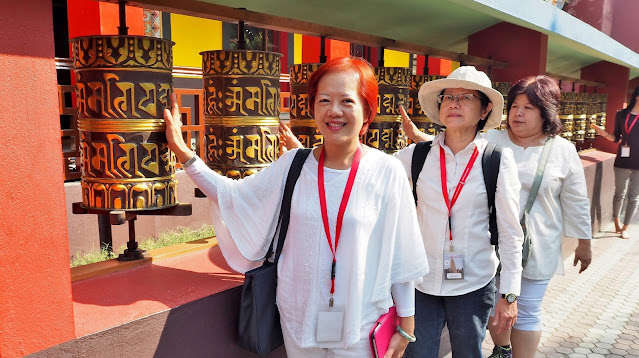
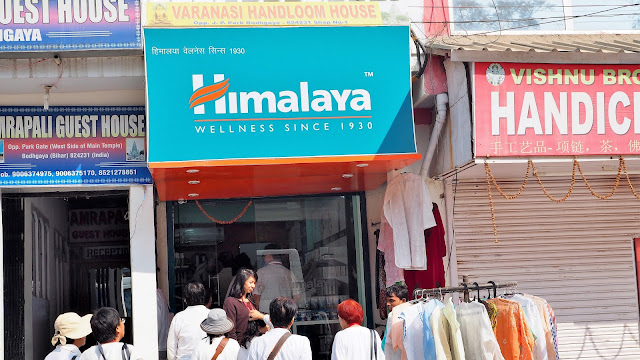
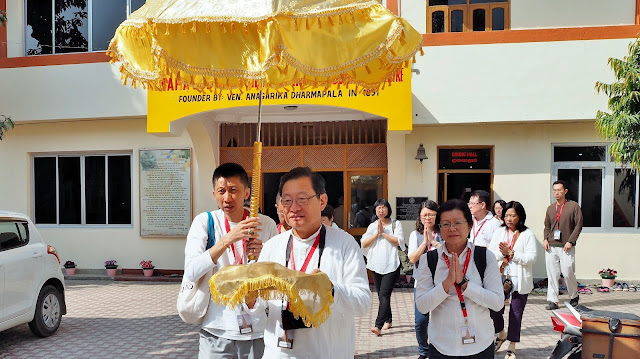
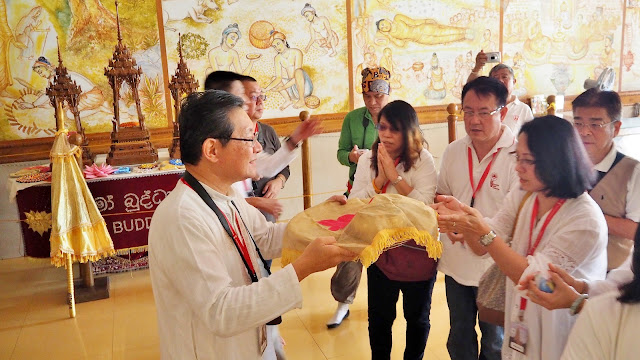














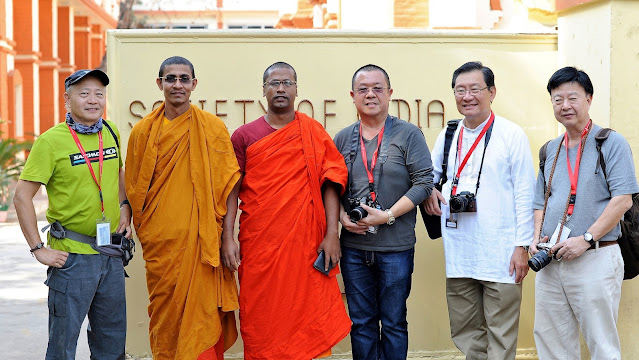























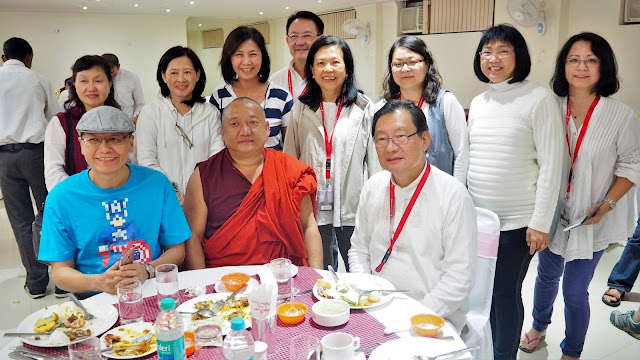










It was just great to be in Bodhgaya (the place of enlightenment of Lord Buddha) on my birthday. Had the opportunity to offer Lunch Dana for holy monks, to carry out morning and evening Puja and meditation and to celebrate birthday with 3 other November babies with fellow spiritual friends. It was just awesome !!
ReplyDeleteExcellent, Ching. It is most interesting and know our trip is recorded in the best way possible via social media.
ReplyDeleteMr Ching, Thanks for the sharing the divine adventure. Best regards, Gan.
ReplyDeleteDear Ching Neng Bin, thank you for your diligence, may the Buddha bless you. Thanks
ReplyDelete